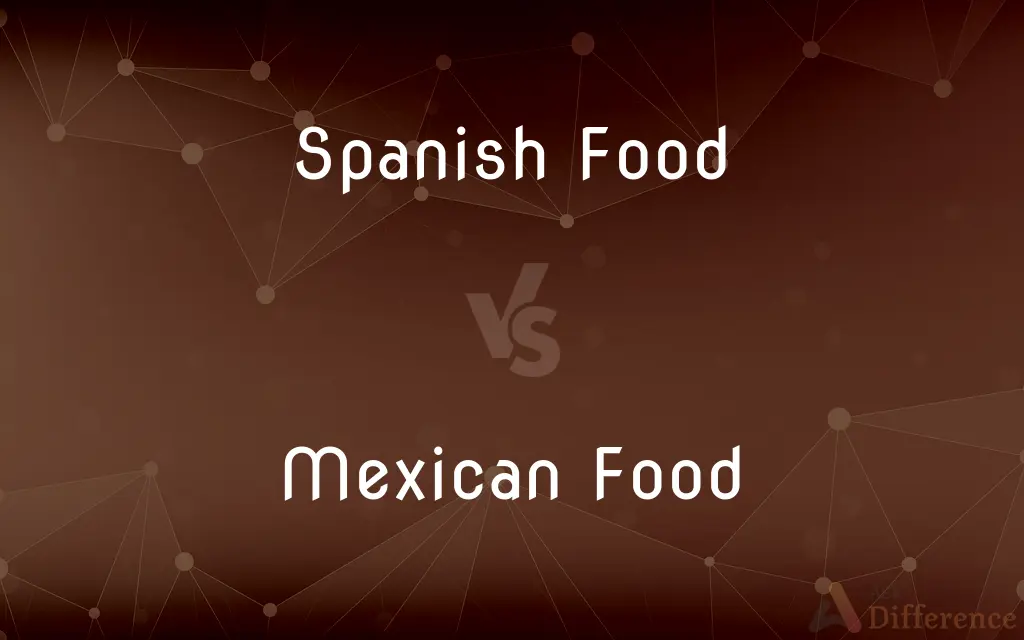Spanish Food vs. Mexican Food — What's the Difference?
By Tayyaba Rehman — Published on December 29, 2023
Spanish Food refers to culinary dishes from Spain, characterized by Mediterranean flavors. Mexican Food refers to dishes from Mexico, known for spicy and indigenous ingredients.

Difference Between Spanish Food and Mexican Food
Table of Contents
ADVERTISEMENT
Key Differences
Spanish Food originates from Spain, a European country with a rich culinary heritage influenced by a variety of cultures including Roman, Arab, and Jewish traditions. It uses ingredients like olive oil, saffron, and Iberico ham. On the other hand, Mexican Food hails from Mexico in North America, deeply rooted in its pre-Colombian traditions and Spanish colonial influences, with staple ingredients like corn, beans, and chilies.
Spanish Food has a strong Mediterranean influence, showcasing flavors of olive oil, tomatoes, and wine. Dishes like paella, tapas, and gazpacho are iconic. In contrast, Mexican Food presents a bold combination of Mesoamerican and Spanish culinary traditions. Dishes like tacos, enchiladas, and guacamole are commonly associated with it.
Spanish Food often includes seafood due to Spain's vast coastline, with dishes like "mariscos" and "calamares" being popular. Mexican Food, while having coastal cuisine, is more known for its use of land-based proteins like beef in burritos or pork in carnitas.
Spanish Food is known for its cured meats, cheeses, and wines, often enjoyed in small servings called tapas. Mexican Food is recognized for its robust flavors with spices, salsas, and a variety of tortilla-based dishes.
Lastly, Spanish Food, being European, showcases flavors familiar to the Mediterranean palette, emphasizing fresh ingredients. Whereas, Mexican Food exhibits a richer, spicier profile, often paired with zesty and tangy accompaniments like lime or cilantro.
ADVERTISEMENT
Comparison Chart
Origin
From Spain, a European nation.
From Mexico, a North American country.
Influences
Mediterranean, Roman, Arab, and Jewish.
Mesoamerican and Spanish colonial.
Common Ingredients
Olive oil, saffron, seafood.
Corn, beans, chilies.
Signature Dishes
Paella, tapas, gazpacho.
Tacos, enchiladas, guacamole.
Flavor Profile
Mediterranean with mild spices.
Bold and spicy with tangy accompaniments.
Compare with Definitions
Spanish Food
A culinary representation of Spain's diverse regions.
The Valencian paella is a pride of Spanish Food.
Mexican Food
A fusion of indigenous Mesoamerican and Spanish culinary practices.
Tacos are an iconic dish in Mexican Food.
Spanish Food
Known for seafood, cured meats, and rich wines.
The variety of seafood in Spanish Food is unparalleled.
Mexican Food
Known for its spicy, rich, and colorful dishes.
Enchiladas are a beloved spicy delicacy in Mexican Food.
Spanish Food
Often served in small, flavorful portions known as tapas.
Enjoying tapas is a quintessential Spanish Food experience.
Mexican Food
Features dishes that are often paired with tangy and zesty sides.
Lime and cilantro are commonly used in Mexican Food.
Spanish Food
A blend of Roman, Arab, and Jewish culinary traditions.
Tapas are a favorite in Spanish Food culture.
Mexican Food
Uses staple ingredients like corn, beans, and chilies.
Corn tortillas are a fundamental part of Mexican Food.
Spanish Food
Traditional dishes influenced by Mediterranean ingredients and flavors.
Olive oil and saffron are staples in Spanish Food.
Mexican Food
Offers a wide range of sauces, from mole to salsa.
Guacamole is a popular sauce in Mexican Food culture.
Common Curiosities
How does Mexican Food differ from Spanish Food in terms of origin?
Mexican Food originates from Mexico in North America, while Spanish Food is from Spain in Europe.
What region does Spanish Food come from?
Spanish Food comes from Spain, a country in Europe.
Are tapas exclusive to Spanish Food?
Yes, tapas are a culinary tradition associated with Spanish Food.
Is paella a part of Mexican Food?
No, paella is a dish associated with Spanish Food.
Are chilies more common in Spanish Food or Mexican Food?
Chilies are more commonly used in Mexican Food.
Which cuisine, between Spanish Food and Mexican Food, is generally spicier?
Mexican Food is generally considered spicier than Spanish Food.
Does Spanish Food have a dish similar to tacos from Mexican Food?
While there are many unique dishes in Spanish Food, there isn't a direct equivalent to tacos.
How has Spanish colonial influence affected Mexican Food?
Spanish colonial influence merged with indigenous Mesoamerican practices to create the rich and diverse cuisine we recognize as Mexican Food today.
Are enchiladas part of Spanish Food?
No, enchiladas are a dish associated with Mexican Food.
Which is more seafood-centric, Spanish Food or Mexican Food?
While both cuisines have seafood dishes, Spanish Food is more renowned for its seafood due to Spain's extensive coastline.
Is guacamole a part of Spanish Food?
No, guacamole is a dish associated with Mexican Food.
What are common ingredients in Spanish Food?
Common ingredients in Spanish Food include olive oil, saffron, and seafood.
Do both Spanish Food and Mexican Food use tortillas?
While both cuisines use tortillas, Mexican Food predominantly uses corn tortillas, and Spanish Food has its own version made from wheat.
Between Spanish Food and Mexican Food, which is known for a wider variety of cured meats?
Spanish Food is particularly known for its variety of cured meats like jamón and chorizo.
What's a signature dish of Spanish Food?
Paella is one of the signature dishes of Spanish Food.
Share Your Discovery

Previous Comparison
Jaiba vs. Cangrejo
Next Comparison
Virtual Machine vs. ServerAuthor Spotlight
Written by
Tayyaba RehmanTayyaba Rehman is a distinguished writer, currently serving as a primary contributor to askdifference.com. As a researcher in semantics and etymology, Tayyaba's passion for the complexity of languages and their distinctions has found a perfect home on the platform. Tayyaba delves into the intricacies of language, distinguishing between commonly confused words and phrases, thereby providing clarity for readers worldwide.












































